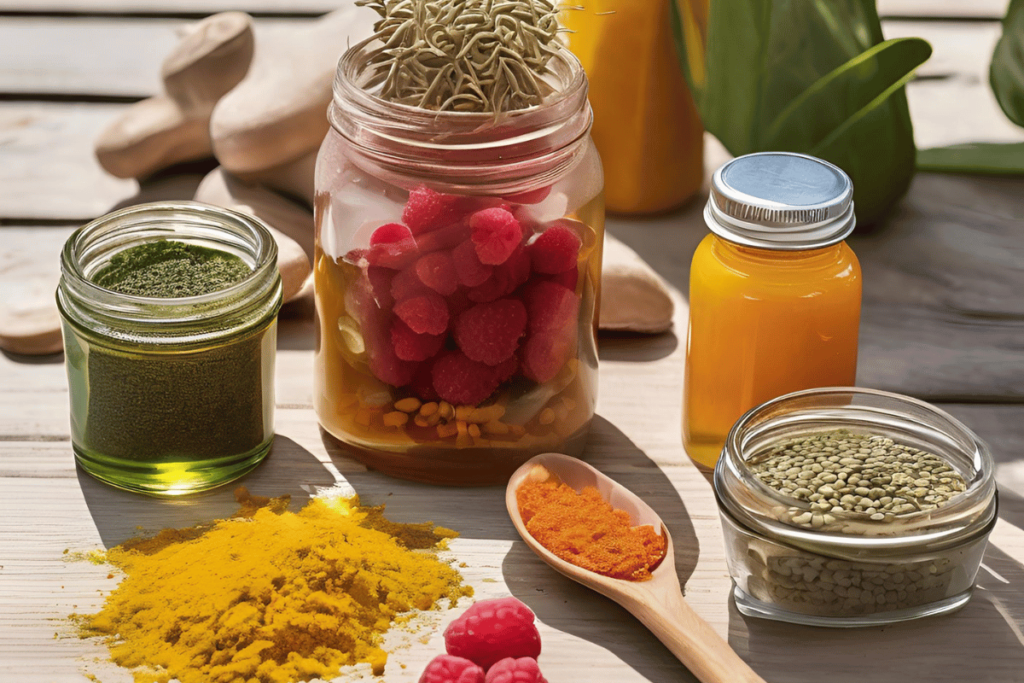
Introduction: Sun-Kissed, Not Sunburnt
Having sensitive skin can feel like treading lightly around a minefield. One moment you’re soaking up the sun’s warm rays, and the next, your skin starts protesting. Having tried countless products with undisclosed chemicals can be daunting, especially if your sensitive skin isn’t responding too well to them- that is where these DIY SUNSCREEN RECIPES for sensitive skin can be your rescue.
So, how can you tell if your skin is sensitive?
Watch for these indicators:
- Redness or irritation after applying skincare products leading to acne sometimes
- Itchiness, burning, or dryness following sun exposure
- Skin that reacts to changes in the environment, such as heat or humidity
If any of these sound familiar, your skin likely craves some extra care—and a reliable sunscreen. Don’t miss the 4th on our list of Top 5 DIY sunscreen recipes for sensitive skin- Surprise! It has an SPF of 50.
Table of Contents
What’s a Sunscreen, Anyway?
Sunscreen acts as a protective barrier for your skin against harmful UV rays that contribute to premature aging, sunburns, and even skin cancer. However, many commercial sunscreens are packed with chemicals that may aggravate sensitivity. This is where homemade, DIY sunscreen recipes for sensitive skin come to the rescue. With the right components, you can craft a sunscreen that is gentle, effective, and free from synthetic ingredients.
Why Go Natural?
When it comes to protecting your sensitive skin, commercial sunscreens may not always be the best option. Here’s why DIY alternatives can be game-changers:
- Gentle Ingredients: Avoid harsh chemicals that can irritate your sensitive skin.
- Eco-Friendly: Eliminate harmful substances like oxybenzone that damage reefs and embrace ocean-safe options.
- Budget-Friendly: Easily prepare a batch without breaking the bank.
Over time, natural sunscreens can enhance your skin’s health while minimizing your reliance on synthetic products. Let’s explore five unique, natural DIY sunscreen recipes for sensitive skin that will turn your skin—and kitchen—into your new best pals.
Recipe 1: Turmeric & Coconut Oil Shield
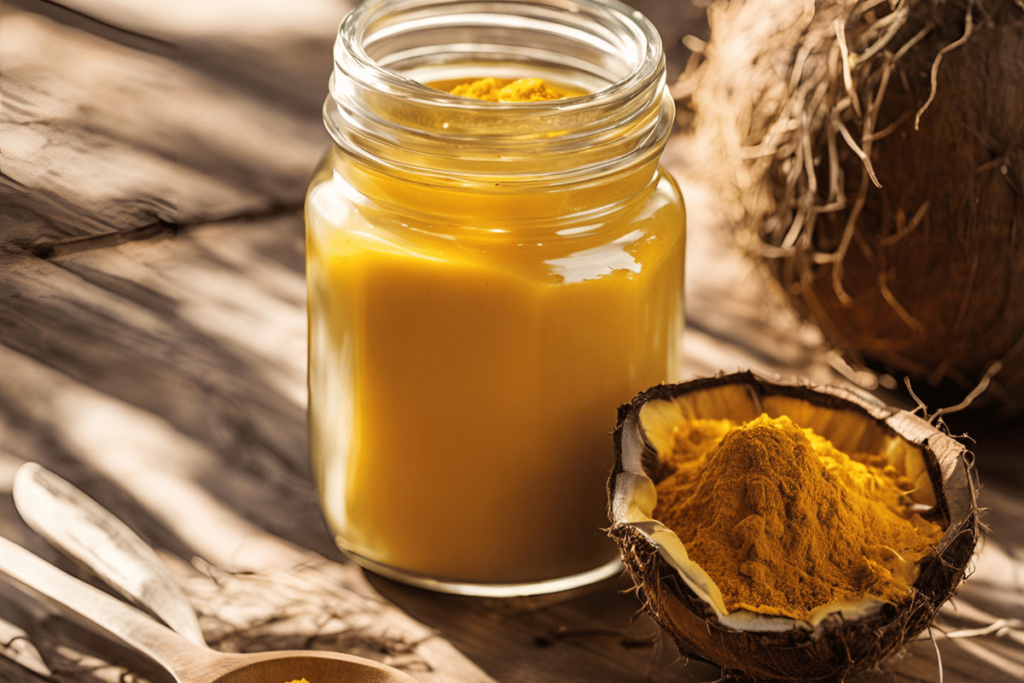
What It Does?
Turmeric boasts anti-inflammatory benefits that calm sensitive skin, while coconut oil moisturizes and offers mild sun protection.
- Preparation Time: 10 minutes
- Shelf Life: 1 week (keep in a cool location)
Ingredients:
- 4 tbsp coconut oil
- ½ tsp turmeric powder
- 2 tbsp zinc oxide powder
- 1 tsp raspberry seed oil (known for high natural SPF)
Method
- Melt the coconut oil in a small bowl.
- Stir in the turmeric powder, raspberry seed oil, and zinc oxide until the mixture is uniform.
- Pour into a small jar and allow it to set.
Why It Works
- Coconut Oil: Hydrates and forms a protective barrier on the skin.
- Turmeric: Alleviates inflammation and shields against sun damage.
- Raspberry Seed Oil: Renowned for its natural SPF attributes.
- Zinc Oxide: Offers broad-spectrum UV protection.
Pro Tip
Apply sparingly—turmeric can leave a temporary yellow hue on your skin.
SPF: Approx. SPF 40
Recipe 2: Aloe Vera & Carrot Seed Oil Cooler
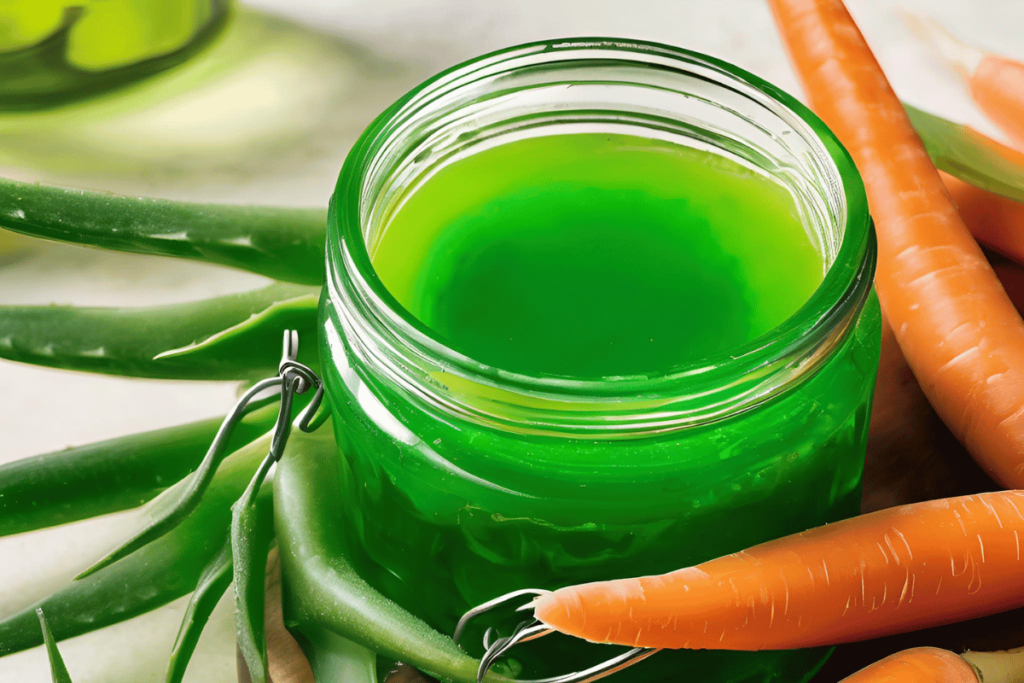
What It Does
Aloe vera calms irritated skin, while carrot seed oil provides natural sun defense and is packed with antioxidants.
- Preparation Time: 15 minutes
- Shelf Life: 10 days (store in the refrigerator)
Ingredients
- 3 tbsp aloe vera gel (fresh or store-bought)
- 2 tsp carrot seed oil
- 2 tbsp shea butter
- 1 tbsp zinc oxide
Method
- Melt shea butter and blend it with aloe vera gel.
- Mix in the carrot seed oil and zinc oxide, stirring thoroughly.
- Store in a glass jar.
Why It Works
- Aloe Vera Gel: Hydrates and soothes sun-damaged or sensitive skin.
- Carrot Seed Oil: Provides natural SPF and is rich in vitamins.
- Shea Butter: Deeply moisturizes and boosts skin elasticity.
- Zinc Oxide: Forms a physical barrier against UV rays.
Pro Tip
For the best soothing effect, use fresh aloe vera gel.
SPF: Approx. SPF 50
Recipe 3: Green Tea & Olive Oil Elixir
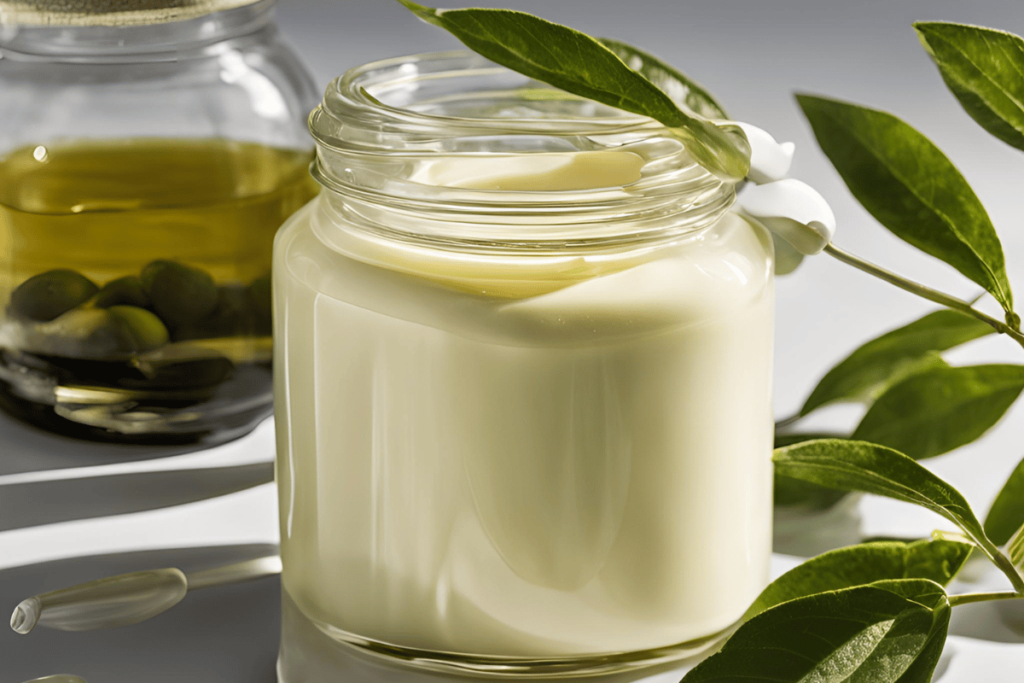
What It Does
Green tea combats free radicals, while olive oil hydrates and safeguards against UV exposure.
- Preparation Time: 20 minutes
- Shelf Life: 1 week (store in a cool, dark environment)
Ingredients
- 2 tbsp green tea (brewed and cooled)
- 3 tbsp olive oil
- 1 tbsp beeswax
- 1 tbsp zinc oxide
Method
- Melt beeswax and olive oil together.
- Gradually add the brewed green tea and zinc oxide while mixing.
- Allow it to cool and then store in a tin.
Why It Works
- Green Tea: Loaded with antioxidants, it counters skin-damaging free radicals.
- Olive Oil: Moisturizes and strengthens the skin barrier.
- Beeswax: Seals in moisture while providing a protective layer.
- Zinc Oxide: Shields against UVA and UVB rays.
Pro Tip
Double strain the green tea to remove any particulate matter from your sunscreen.
SPF: Approx. SPF 40
Recipe 4: Almond & Sandalwood Glow DIY Sunscreen Recipe for sensitive skin

What It Does
Almond oil nourishes and hydrates, while sandalwood powder cools and calms sensitive skin.
- Preparation Time: 10 minutes
- Shelf Life: 2 weeks
Ingredients
- 3 tbsp almond oil
- 1 tsp sandalwood powder
- 2 tbsp zinc oxide
- 1 tsp raspberry seed oil
Method
- Combine almond oil and sandalwood powder until smooth.
- Incorporate zinc oxide and raspberry seed oil, mixing thoroughly.
- Store in a glass container.
Why It Works
- Almond Oil: Rich in vitamins E and K, it nourishes and restores.
- Sandalwood Powder: Offers cooling and anti-inflammatory properties.
- Raspberry Seed Oil: Introduces SPF and combats signs of aging.
- Zinc Oxide: Ensures UV protection.
Pro Tip
This can double as a light moisturizer—perfect for everyday use.
SPF: Approx. SPF 50
Recipe 5: Cucumber & Rose Water Mist
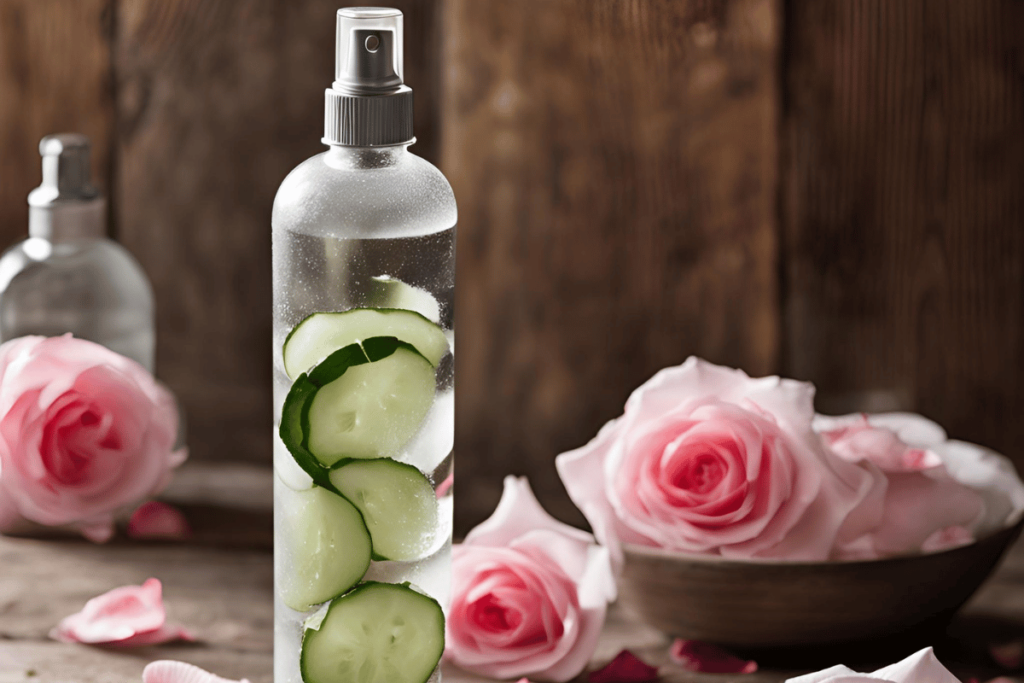
What It Does
Cucumber hydrates and cools, while rose water tones and calms sensitive skin.
- Preparation Time: 10 minutes
- Shelf Life: 1 week (keep refrigerated)
Ingredients
- 1 cucumber (juiced)
- 3 tbsp rose water
- 2 tbsp aloe vera gel
- 1 tbsp zinc oxide
Method
- Juice the cucumber and strain the liquid.
- Combine cucumber juice with rose water, aloe vera gel, and zinc oxide.
- Transfer to a spray bottle for convenient application.
Why It Works
- Cucumber Juice: Hydrates and refreshes the skin.
- Rose Water: Balances the skin’s pH and imparts a natural glow.
- Aloe Vera Gel: Soothes and protects against sun damage.
- Zinc Oxide: Shields your skin from harmful UV rays.
Pro Tip
Store it in the fridge for an extra cooling effect on hot days.
SPF: Approx. SPF 40
Common Mistakes to Avoid When Making DIY Sunscreen recipes for Sensitive Skin
Creating your own sunscreen is empowering, but it’s important to avoid common pitfalls to ensure your skin remains protected.
- Skipping the Patch Test: Sensitive skin needs special care. Always test your DIY sunscreen on a small patch of skin before applying it to your entire face.
- Not Using High SPF Ingredients: Zinc oxide and red raspberry seed oil are essential for providing adequate protection. Ensure your DIY sunscreen contains enough of these.
- Overlooking Reapplication: Even natural sunscreens need to be reapplied every 2 hours when exposed to sunlight.
- Improper Storage: Store your DIY sunscreen in a cool, dark place to preserve the potency of natural ingredients.
By being mindful of these mistakes, your DIY sunscreen recipes for sensitive skin will work effectively without irritation.
These DIY sunscreen recipes for sensitive skin offer you a chemical-free solution tailored specifically for your delicate skin type.
Tips for Maximizing Sun Protection Naturally
Making DIY Sunscreen recipes for sensitive skin is just one part of the equation. Here are some additional tips to keep your skin safe under the sun:
- Layer Up: Wear a wide-brimmed hat, UV-blocking sunglasses, and long-sleeved clothing for added protection.
- Seek Shade: Avoid the sun during peak hours (10 AM to 4 PM) when UV rays are strongest.
- Eat Antioxidant-Rich Foods: Foods like berries, green tea, and dark chocolate help protect your skin from within.
- Hydrate: Sun exposure dehydrates the skin, so drink plenty of water throughout the day.
- Reapply Often: Even natural solutions need regular reapplication after sweating or swimming.
By combining natural sunscreens with these sun-smart habits, you’ll enjoy a fun and worry-free summer!
FAQ: Your Questions, Answered
- Can homemade sunscreen replace store-bought ones? These Homemade DIY sunscreen recipes for sensitive skin are excellent for everyday use but may not provide the extensive protection needed during intense sun exposure. Frequent reapplication is a must.
- How often should I reapply homemade sunscreen?Reapply every 2 hours, particularly if you’re sweating or swimming.
- Is zinc oxide safe for sensitive skin?Absolutely! Zinc oxide is gentle and offers excellent UV protection without causing irritation.
- Can I skip sunscreen on cloudy days?Not at all! UV rays can still penetrate clouds, so any of the above DIY sunscreen recipes for sensitive skin is necessary every single day.
- Do these recipes work for all skin types?Yes, but it’s advisable to do a patch test to ensure there are no allergic reactions.
Conclusion: Your Skin’s New BFF

Sensitive skin doesn’t have to be a constant struggle. With these DIY sunscreen recipes for sensitive skin, you can protect your skin from the sun both naturally and effectively, while also enjoying the fun of making your own skincare. Ready to pamper your skin? Gather those ingredients and let’s get glowing!

Pingback: How To Identify Your Skin Type: Top Skin Secrets Revealed!
YvwuVliy xKo AfEAZQVj AGI DyISQaZ DwKm